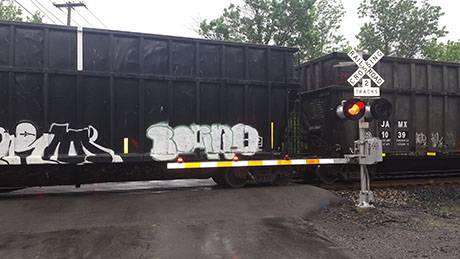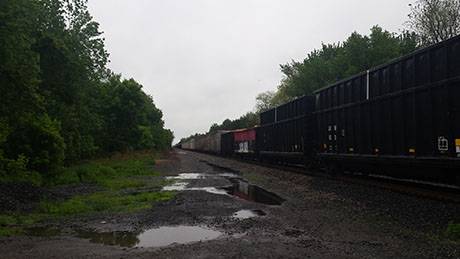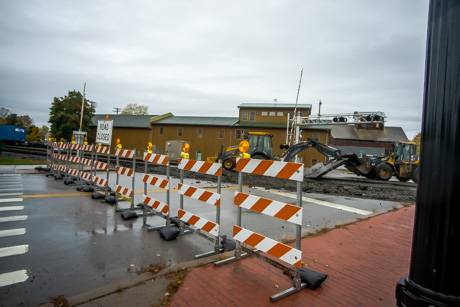Crude oil makes up the lion's share of commodities rumbling over railways traversing Genesee County. Ethanol is number two. And if a railcar carrying one of these highly volatile products derailed, it would not be good.
"Neither one of those things are really good products for us to see 100-car trains going through with 30,000 gallons on each one," said Tim Yaeger, county Emergency Services manager, who gave a review of his department Tuesday at the Public Service Committee.
"That's a lot of product going through. Bakken is down to one to two shipments a day; it was up to three, to four, even five at one time, but petroleum prices drive that."
(Bakken oil comes from a massive shale formation primarily in North Dakota, but it is also found in Montana and two Canadian provinces.)
And yet any rail disaster here now would likely be more ably dealt with than in the past.
There's a couple of reasons for that.
Firstly, the railroad operator, CSX, is more concentrated these days on public safety that in moving products swiftly. That's the sense Yaeger said he got from attending a CSX hazardous material outreach training program, which he lauded as "excellent."
"I can tell you that CSX really impressed me -- their commitment to safety, their commitment to communities," Yaeger said. "It used to be their number-one goal was to get the train moving again. Now it's really safety and making sure that the community is safe before they worry about moving trains again."
The emphasis on beneficial PR is probably, at least partially, rooted in the call for industry-wide reform that followed the company's disastrous derailment accident in Lynchburg, Va., in May 2014 in which tankers carrying crude oil caught fire along with the James River.
At the time, a former chairman of the National Transportation Safety Board said it was a "wake-up call" for a slow, ineffectual federal rule-making process that failed to protect Amercians in a time when the amount of crude oil being moved by rail in the United States quadrupled in less that a decade.
"They've showed their weaknesses over the years," Yaeger acknowleged. "They show their ability now to respond better and integrate with the local communities as well. I was pleased."
Secondly, in conjunction with CSX training, representatives from the Department of Environmental Conservation traveled throughout the state in the spring developing emergency response plans for the entire rail system in the State of New York, working with local officials in each county.
"Basically, they come in and look at hazards within that area -- with about a five-mile buffer on either side of the tracks -- and find out what type of infrastructure is in the area -- schools, hospitals, things like that in the community -- and then identify the resources that we need to respond to that area," Yaeger explained to the committee.
In his CSX disaster training, Yaeger said he learned that "the entire heat signature goes up, not outward. So our concern, the fire service concern, is that we can't get near it because the amount of BTUs that come off the material is difficult. We have to basically wait for it to burn down.
"Luckily, 'the whip' -- its path -- is not that long. If we have a spill or a movement downhill or into a waterway ... it's a bad event, (but) it's really impressive to see what happens when that catches fire and we have multiple products. The actual damage is about 500 to 1,000 feet, so although it looks terrible, it's not that bad and that heat is going straight up."
Today, first responders in the fire service have full masks to wear to protect themselves from the fumes in fighting this type of conflagration. But they also have a different view about the appropriate response, as compared to, say, the state.
"The state has a different philosophy," Yaeger said, "that we're going in and save the day. And talking to the experts, you're going to be fried before you get close enough to try and do any of those things."
Rather, firefighters are going to use water to cool the exposures first, cool the tanks, and keep them from exploding. (This is known as a B.L.E.V.E -- pronounced "blevy" -- or Boiling Liquid Expanding Vapor Explosion, which is an explosion caused by the rupture of a vessel containing pressurized liquid above its boiling point.)
Foam is not going to be employed initially.
"When the fire's out, we try and suppress the vapors, and then we'll be applying the foam."
Useful, too, is a new software program in the Emergency Services office to track "any shipment of cargo through this county," Yaeger said.
Genesee County training for reaction to volatile commodity spills on highways or railways is continuing with sessions in Baltimore, and Pueblo, Colo.
Overall, emergency response education is strong and productive, with 344 students having participated this year in state programs at the local fire training center, and 22 students completed advanced EMT classes.
On the communications side, Emergency Services is testing pagers with new technology that allows them to switch between 800 megahertz (emergency dispatch radio) and VHF (paging) frequencies. They can be purchased, in conjunction with the Sheriff's Office, with government grant money.
After the county switched to the new emergency dispatch system, procedures changed; certain channels were no longer available and this created issues with first responders who were out of radio range.
The new pagers being tested are not radios. Those paged to respond to a call can't speak on them, but they can hear emergency dispatches and the directives of the incident commander on scene.
Before, responders would be paged on their pager, but then have to get within range of an 800 megahertz radio frequency to hear the emergency dispatch conversations. The new pagers are like "little scanners" that can switch between the two banks "to hear both sides of the conversation." They cost a couple of hundred dollars more than the old pagers and would only be provided to key individuals who "are always responding."
In terms his investigation team, Yaeger said workers are continuing their certifications and they are looking to retool how they do business in light of "the cancer issues that were coming out of the fire service."
Example: there are now more detailed processes in place for handling contaminated gear -- evaluating what gets bagged, what gets disposed of, what gets sent out and cleaned and brought back into service.
As regards fire records management, Yaeger said that 18 fire departments and first responders are now using the same records management system. Le Roy Ambulance Service is expected to join soon.
Public Service Committee Member Rochelle Stein asked how that was going, if it's serving the communities' needs and if everybody likes it.
" 'Like' is a subjective term," Yaeger quipped, and that got a laugh. He offered the word "tolerate" in lieu of "like" and credited Bill Schutt, West Battalion coordinator for the Genesee County Emergency Management Office, for deftly handling the customer-service aspect of things.
"We're 100-percent reporting," Yaeger noted. "That's very important to New York State. Everybody's reporting their incidents. We're breaking some records. We had some issues, but it's working well."



